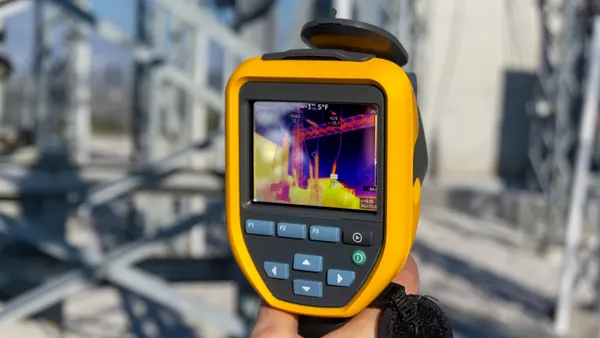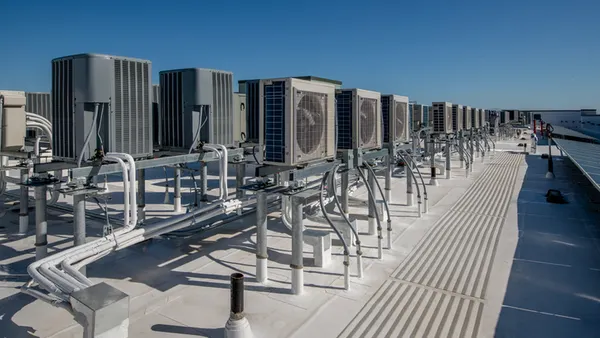Dive Brief:
- U.S. General Service Administration officials are doubtful of their ability to meet future federal sustainability goals amid a lack of access to capital and carbon-free electricity, a U.S. Government Accountability Office study found.
- Agency officials said the scale and scope of projects needed to achieve net-zero building emissions by 2045 will require resources beyond what has historically been available, the GAO report noted.
- The GSA will need to provide upfront funding on a more regular basis to make energy savings performance contracts economically viable, GSA officials said in the report.
Dive Insight:
The GSA owns or leases about 8,600 buildings spanning 371 million square feet for federal agencies, which rely on these buildings for uses ranging from office space and laboratories to courthouses and post offices. GSA’s building portfolio includes more than 1,500 owned buildings averaging more than 50 years old. These aged federal buildings consume ample energy and emit significant amounts of greenhouse gasses.
The study, which involved interviews with officials from GSA’s central office and each of the agency’s 11 regional offices, is an offshoot of a GAO performance audit conducted from March 2022 through September 2023, and reviews the GSA’s efforts to implement sustainability measures across its buildings portfolio. The GAO said it reviewed facilities standards, laws, executive orders, GSA policies and sustainability goals.
Officials from eight of 11 GSA regions reported that they are either “not at all confident” or only “slightly confident” of their ability to achieve the new goal of net-zero emissions by 2045. Officials from more than half of GSA's locations told GAO their access to carbon-free electricity is limited and nearly all respondents expressed little or no confidence in their ability to achieve the goal of 100% carbon-free electricity use by 2030. To that end, the GSA has launched an office to identify opportunities for interagency coordination on carbon-free electricity purchases, the report said.
As part of the annual budget process, GSA estimates and requests funds required for its capital investment program for the upcoming fiscal year, including sustainability projects. Congress subsequently appropriates funding for GSA to implement its projects, but this amount may differ from what GSA requested, the report stated.
The Infrastructure Investment and Jobs Act includes $3.4 billion for GSA to construct, acquire, repair and alter land ports of entry; $2.15 billion for the purchase of low-carbon building materials in construction projects; $975 million to support emerging and sustainable technologies; and $250 million to encourage conversions of more buildings into high-performance green buildings.
Energy savings performance contracts are another source of funding, where GSA partners with energy services companies for a period of time to implement cost-saving energy improvements that require little to no upfront capital costs. The energy service companies typically finance and manage projects that involve replacing existing building system components with more energy-efficient ones. GSA makes contractual payments up to the duration of the contract based on expected savings from the energy-efficiency upgrades. In instances where savings over that payback period fall short of project costs, the GSA will need to provide upfront funding to cover the difference, if it chooses to pursue the project, the report said.
Bob Hunt, leader of the state and local government advisory team at JLL’s public institutions practice pointed to a repair and alterations fund, where some of GSA’s revenue is channeled toward deferred maintenance. “But Congress has not let them have access to it for a number of years. And so, sometimes, it’s not so much that there isn’t the desire. They aren’t structurally set up to actually implement it,” Hunt told Facilities Dive.
“If you have a project that’s over $3 million,” he added, “you literally have to apply to Congress to get funding to make it move, which is a several-year process. So,, in a lot of ways, they're hampered by their own internal structures and regulations and funding sources.”
Central office officials at GSA said reaching net-zero building emissions will require massive projects in many existing buildings to replace fossil fuel-based equipment, like boilers and water heaters, with electrically operated systems. The report said these officials are presently assessing strategies to electrify buildings, alongside deep energy retrofits aimed at increasing energy efficiency, as the primary strategy for reaching the net-zero emissions objective.
In the short term, officials anticipate that GSA will have to implement such projects in at least 46 facilities totaling 32 million gross square feet, from among its 151 applicable facilities spanning 109 million gross square feet, to fulfill the interim target established by the Federal Building Performance Standard. That target requires agencies to attain zero scope 1 emissions in 30% of their buildings by 2030.
The long-term sustainability goals set in a 2021 executive order include requirements for agencies’ buildings to obtain electricity from carbon-free sources and reach net-zero greenhouse gas emissions by 2030. The order also mandates at least half of that electricity to come from locally supplied clean energy to meet round-the-clock demand. Subsequently, GSA updated its practices to promote energy efficiency in buildings and a reduction in emissions.










